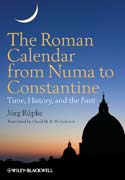
The Roman calendar from Numa to Constantine: time, history, and the fasti
Rüpke, Jörg
Richardson, David M.B.
This book provides a definitive account of the history of the Roman calendar,offering new reconstructions of its development that demand serious revisionsto previous accounts. Examines the critical stages of the technical, political, and religious history of the Roman calendar Provides a comprehensive historical and social contextualization of ancient calendars and chronicles Highlights the unique characteristics which are still visible in the most dominant modern global calendar INDICE: Preface. Map 1 Distribution of preserved calendars (or calendar fragments) of the fasti type from the first century BCE to the fifth century CE.Table 1 List of known copies of fasti. 1 Times social dimension. 2 Observations on the Roman fasti. 2.1 A Republican version. 2.2 Forms and functions. 2.3 The fasti and the birth of Augustan epigraphy. 2.4 The question of the archetype. 3 Towards an early history of the Roman calendar. 3.1 Notions of a prehistoric calendar. 3.2 The structure of the month. 3.3 Market cycles. 3.4 Modes ofdating. 4 The introduction of the Republican calendar. 4.1 Timing and motivation. 4.2 The character and significance of the reform. 5 The written calendar.5.1 Gnaeus Flavius. 5.2 NP days and feast-names. 5.3 Cultic and linguistic details. 5.4 The purpose of the fasti. 5.5 The law of Hortensius. 5.6 Implications for the historiography of Roman religion. 5.7 Variants on stone and paper. 6 The Acilian law and the problem of pontifical intercalation. 6.1 The nature of the measures. 6.2 How to intercalate in a ritually correct manner? 6.3 Problems of intercalation. 6.4 Regulating intercalation by means of laws. 7 Reinterpretation of the fasti in the temple of the Muses. 7.1 Marcus Fulvius Nobilior, triumphator. 7.2 Temple dedications in the fasti. 7.3 Ennius. 7.4 All fastiare Fulvian fasti. 8 From Republic to Empire. 8.1 Caesar's reform of the calendar. 8.2 The calendar as collective memory. 8.3 Augustus and the power of dates. 8.4 The calendar as Roman breviary. 9 The disappearance of marble calendars. 10 Calendar monopoly and competition between calendars. 10.1 One calendar. 10.2 Coexisting and competing developments. 10.3 Eras. 10.4 The calculation ofEaster. 10.5 Weekly cycles. 10.6 Fasti christiani? 11 The calendar in the public realm. Abbreviations. References. Sources Index. General Index.
- ISBN: 978-0-470-65508-5
- Editorial: John Wiley & Sons
- Encuadernacion: Cartoné
- Páginas: 240
- Fecha Publicación: 18/04/2011
- Nº Volúmenes: 1
- Idioma: Inglés
